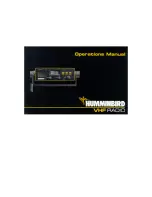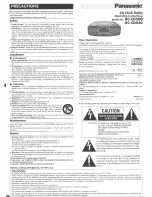
What You Need
Your Humminbird VHF radio requires the connection of a VHF marine band antenna. These
antennas are readily available through marine distributors and come in a variety of shapes,
materials, and mounting types.
A high Quality antenna will maximize your transmit range and reception clarity, and compliment
your Humminbird VHF radio.
You can use your Humminbird VHF radio with any other quality marine band antenna . If you
intend to use a previously installed antenna, check it before installing your radio to make sure all
connections are tight and free of corrosion.
Note: Do not operate the Humminbird VHF radio without an antenna, or with a “CB” antenna.
Attempting to do so may damage the unit. Humminbird is not responsible for damages caused by
operation without an antenna or with an inappropriate antenna.
In addition to the antenna options listed previously, Humminbird offers the following optional
accessory for your VHF radio.
Accessory Part No. Use
Speaker adapter SAC-R Allows
Cable connection of
External speaker
For more information on these accessories, contact your local Humminbird dealer or call our toll-
free Customer Support Hotline.
OBTAINING APPROPRIATE LICENSES
Before operating your Humminbird VHF radio, you must apply for the appropriate licenses. For
your convenience, the product box includes license applications that you can fill out and mail as
instructed on each application.
Ship Station License
Any craft equipped with a VHF/FM transceiver (such as your Humminbird VHF radio) is
considered a Ship Station, and must carry a current Ship Station License. It is unlawful to operate
an unlicensed Ship Station. Your license will state the call sign, which is your craft’s identification
for radio purposes.
Be sure to complete and mail the Ship Radiotelephone License application (FCC Form 506A),
provided with your Humminbird VHF radio. You may obtain an interim Ship’s Stations license by
appearing in person at your local FCC Field Office.
Operator’s License
In the U.S., you may need to apply for a Restricted Radiotelephone Operator Permit, or higher
grade license, before operating your Humminbird VHF radio. (The operator’s license is not
required for voluntary equipped vessels on domestic voyages. To apply, complete and mail FCC
Form 753, provided with your Humminbird VHF radio. An interim permit is automatically granted
upon submission of the application. Other countries may have specific licensing requirements.
Summary of Contents for DC 25
Page 1: ......





























